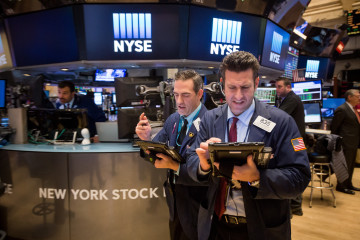Matt Levine’s Money Stuff: VIX Hedging and College Sports

(Bloomberg View) —
VIX manipulation
We talked on Wednesday about the CBOE Volatility Index, the VIX, which is an index of implied volatility based on S&P 500 Index stock options. The VIX is used as the reference for VIX futures and options, and we discussed a paper by John Griffin and Amin Shams of the University of Texas arguing that a monthly auction for the S&P 500 options is manipulated to influence the price of the VIX and the settlement prices of VIX derivatives.
One thing that I said on Wednesday is that VIX derivatives are all cash settled: “The VIX is not a thing you can own, so if your option ends up in the money you just get paid cash for the value of the VIX at settlement.” That’s mostly true — they are cash settled — but in a sense the VIX is a thing you can own. The VIX is calculated based on the prices of a strip of underlying S&P 500 options, so you could “own” the VIX by buying those options. (This is very loose — the options, unlike the VIX, are not pure volatility products, and you’d want to hedge their S&P price exposure — but it’s a useful abstraction.) And you could even imagine a VIX derivative that was physically settled instead of cash settled: If you bought a VIX future with a price of 12, then at maturity you’d deliver $12 and your counterparty would deliver the underlying S&P 500 options. Which would be worth $13 if the VIX was at 13, or $11 if it was at 11, etc. (Not really — they’d be worth $13 or $11 of vega — but, again, abstraction.) This is like how, say, oil futures notionally work: You buy an oil future, so you have exposure to oil, and then it expires, but you still have exposure to oil, because you have received a delivery of oil.
Again, that product doesn’t exist for the VIX. But you can create it! Let’s say you own VIX futures for some reason — as an outright bet on volatility, or a hedge to some other trade. When your futures expire, they will pay you cash. But you might not want cash: You wanted volatility exposure yesterday, and you might want the same exposure tomorrow, for the same reason. So when the futures settle in cash, you can just use the cash to buy the options. If you bought a VIX future with a price of 12, and at maturity the VIX is 13, you’d get the $13 in cash and spend it on buying the underlying S&P 500 options that make up the VIX. And then the day after settlement, you would sort of have the same exposure — the exposure to S&P 500 volatility as measured by the VIX — as you did the day before settlement. And the most seamless and efficient way to do that would be to buy that strip of options in the VIX settlement auction.
That is, I think, the best innocent explanation for Griffin’s and Shams’s findings that people seem to trade a lot of VIX-underlying options in the VIX settlement auction. They attribute it to manipulation — people buy underlying VIX options to push up the settlement price of the VIX — but it may just be people rolling their positions. Pravit Chintawongvanich of Macro Risk Advisors points out in a client note:
Some of our most VIX-savvy clients argue that this is not “manipulation” at all, but simply the means which liquidity providers replace their risk. Since VIX products are cash settled, the settlement offers an opportunity for VIX liquidity providers to replace their expiring VIX risk with S&P options. For example, imagine a market maker who trades VIX futures vs. S&P options. On the morning of settle, the VIX futures side suddenly disappears into cash, which would leave them un-hedged. The far out-of-the-money options normally being illiquid, there should naturally be more demand for trading these during the morning of settlement.
This is a general feature of derivatives markets: You are often trading in the underlying, to put on or unwind or hedge or roll derivatives positions, in ways that influence the price of your derivative. Your motivation could be to keep your risk constant, or to move the price, or both. And the person on the other side of the trade may be doing exactly offsetting hedging trades. In isolation, buying a lot of S&P options when you have a derivative referencing those options could look like manipulation, or it could be very normal hedging behavior.
Griffin and Shams consider this explanation in their paper, by the way, but they argue that, “inconsistent with a sudden demand for such a specific SPX position, we find no volume jump on the VIX settlement day for other tightly related exchange-traded products that mimic the same payoff.” Transforming a VIX futures position into an options position is perhaps not the most intuitive way to keep your volatility exposure. Lots of traders don’t take physical delivery on their oil futures either: If you have oil exposure via oil futures, and you want to keep the exposure, and the futures are expiring, it’s a lot easier to just roll your position into new futures than to actually take delivery of a bunch of barrels of oil. In S&P 500 volatility, too, you might roll into new VIX futures rather than going out and buying the options. Also, it is possible that both things — turning VIX futures into options, and also manipulation — are going on.
Quants quants quants quants.
Here’s a story about how Ivy League athletes are being displaced by Ivy League computer scientists in Wall Street recruiting. You shouldn’t overstate that trend: For the foreseeable future, investment banks will need to hire risk-takers who work hard, are good team players, stay calm under pressure, and are fun to go out drinking with, and they will continue to look to college lacrosse teams for those characteristics. Still I am not entirely convinced by the athletes’ claims:
They say the core attributes needed to make multimillion-dollar bets are discipline and quick thinking—two traits honed by sports. They argue those skills are still invaluable in the corporate bond market, where banks and other intermediaries take chances every time they hold securities as they look to match buyers with sellers. This is especially true in moments when prices swing violently.
“It’s hard to replace that with artificial intelligence,” Mr. Bahl said.
Why? I mean obviously computers think more quickly than humans do, that is the point of computers. They are also likely to be more disciplined, insofar as they have no emotions, don’t get tired, will never exceed their programmed risk limits, etc. There are a whole lot of industries that die out to the sound of special pleading. “You can’t replace us, customers really want our human touch and personal insight, a machine can never do what we do,” the last travel agents and bond traders and financial journalists will say.
Meanwhile, I said yesterday that Silicon Valley is where data scientists go to work on advertising models and pretend that they’re saving the world, while Wall Street is where data scientists go to work on trading models and not do that, but I missed a possibility. Data scientists can also go to Wall Street to build advertising models:
“The same value we get on the investing side from big data and algorithms and looking at trends and responding to them—we’d like to do that on the advertising side,” said Jennifer Grancio, head of global business development at BlackRock’s iShares ETF business.
Aramco.
Here is a story about a beauty pageant that is related to Saudi Arabian Oil Co.’s proposed initial public offering, but it is not about the metaphorical sort of “beauty pageant” where bankers trek out to Saudi Arabia to pitch their credentials and try to get hired on the deal. No, it is about a literal beauty pageant, but for camels: Saudi Arabia’s royal family wanted a fancy new complex to host the camel pageant, and so Saudi Aramco quickly built one at a cost of about $55 million. It does a lot of random construction projects, actually: “Aramco was also involved in building the counter-terrorism center in Riyadh where President Donald Trump and King Salman were photographed earlier this week touching a glowing orb.”
The question, for a potential investor in Aramco’s IPO, is: Do you want your company spending its money building public projects for the Saudi royal family? And how confident can you be that the company is getting a good deal?
Saudi Aramco’s chairman, Saudi Energy Minister Khalid al-Falih, said in a March interview that Aramco is “ring-fenced financially” from the state, with governance comparable to multinationals.
Yet people familiar with the behemoth’s finances say that it is often unclear even to some officials high up in the company whether Aramco has been reimbursed in full for projects, and how the reimbursement process works.
These are particularly difficult questions in that they are traditionally answered by governance rights: If a regular company goes public in the regular way, and then it spends its money on vanity projects for friends of its chief executive officer, the board can fire the CEO, or an activist can persuade shareholders to vote out the board. (Or shareholders can sue in state court for breaches of fiduciary duty.) It is hard for a company credibly to commit to a standard like “we will act in our shareholders’ interests, not our executives’,” which is why that expectation is usually enforced by shareholder voting — and why it is sometimes not all that well enforced in companies that are controlled by one shareholder.
Elsewhere in state oil companies: “Venezuela Secretly Plotted to Sell Banned Syrian Oil to the U.S.” The oil would go through a Russian shell company because, you know, in for a penny, in for a pound. The plot seems to have been the idea of Venezuelan oil trader Wilmer Ruperti, who does not have much of a talent for codenames:
In a September 2012 letter to Syria’s then-ambassador to Venezuela, Ghassan Abbas, Ruperti said the point of the scheme would be to “avoid the boycott that has been implemented by United States of America and the European Community.”
He proposed heading a business group called “Sirius Venezuelan” and recommended a five-year contract to supply 50,000 to 200,000 barrels a day of Syrian crude, as well as storage capacity for another 6 million Syrian barrels. Stamped beneath Ruperti’s signature, in bold italics: “Socialist fatherland, we will win and we will live.”
“Sirius Venezuelan”! No one would ever guess.
Blockchain blockchain blockchain.
Here is Kin, the cryptocurrency for Kik, the chat app. I don’t really understand why a chat app would need a cryptocurrency but, you know, stickers:
Once we have established the new cryptocurrency, we will create demand for it by encouraging people to earn and spend Kin within Kik, which is used by millions of people every day. Since 2014, we have experimented with a digital currency called Kik Points, which allowed people to earn points by watching ads. They could then spend those points on digital items, such as stickers or emoji. Despite its intentional limitations, Kik Points saw a transaction volume three times higher than Bitcoin’s. As the default currency inside Kik, Kin will go far beyond Kik Points by allowing people to participate in an economy based on buying and selling stickers, hosting and joining group chats, creating and using bots, and much more.
Here is venture capitalist Fred Wilson on the idea. And Joe Weisenthal argues (on Twitter, and in the Bloomberg Markets newsletter) for a Facebook Inc. currency:
Imagine, for a second, if Facebook not only launched its own currency (“Facebucks”) but imposed a tax every year, levied in Facebucks, upon companies that wanted prioritized access to its newsfeed. That tax would instantly create a source of demand, and the currency would have value. Then people could use it for other stuff, and it might actually thrive. Anyway, it seems unlikely to happen, but if a company with hegemonic economic power wanted to, they could probably be successful launching their own currency, and then demand companies pay them by using it.
Sure, why not. The default expectation for much of human history has been that currency was associated with power: If you run a state, you get to mint and control the currency in that state. Bitcoin and other cryptocurrencies were built on the idea of dissociating currency and power: Currencies could have value because people believed in them, without any state sanction. Perhaps the currency-power linkage is more stable, but the link between power and traditional states has broken down. Maybe social media companies and chat apps have replaced nation-states as the centers of power in the modern world; maybe they should be minting currencies.
Elsewhere, the Bank of Canada is not so sure that its centralized ledger keeping track of Canadian dollars should really be replaced by a blockchain:
“At its heart, there exists a fundamental inconsistency or tension between a centralized wholesale interbank payment system, as we have now, and the decentralization inherent in DLT.”
Against “and.”
“Academic politics are so vicious because the stakes are so low,” and here is a story of a group of economists who staged a successful revolt against their boss over the word “and”:
The World Bank’s chief economist has been stripped of his management duties after researchers rebelled against his efforts to make them communicate more clearly, including curbs on the written use of “and.”
Paul Romer remains the chief economist, but is no longer in charge of the researchers in the Development Economics Group, apparently because he thought they were too vague and verbose. Of course the stakes at the World Bank aren’t especially low, or at least they don’t have to be. “Romer expressed to those around him that the department should communicate more clearly, dive right into public debates, and align its work with the institution’s goals of ending extreme poverty and reducing inequality.” It is easier to do that if you write clearly. Here is Romer’s defense/semi-apology, and here is his internal blog post about “and”:
When a linguist and a computer scientist looked at the Bank’s annual reports, they found patterns we can track. One is the use of “and” to offer something for everyone: “… promote corporate governance and competition policies and reform and privatize state-owned enterprises and labor market/social protection reform …”
Yeah look that’s too many “ands”! If you want your research to actually influence policy, it probably is helpful if it expresses clear conclusions and priorities, rather than listing everything that anyone might want. I don’t know that cutting out “and” is a perfect proxy for making hard choices and focusing one’s recommendations, but I see where Romer’s coming from.
People are worried that people aren’t worried enough.
Dean Curnutt of Macro Risk Advisors worries, at Bloomberg Prophets, about complacency in the face of weird geopolitical events: “Of all the dangers in the world of finance, the enduring low level of market volatility is the most significant.” But James Stewart argues that markets should be pretty complacent about all the political stuff:
By and large, “investors should tune out political events,” said James B. Stack, president of InvesTech Research and Stack Financial Management, who has done a study of what he calls “crisis events” and their effect on markets. “Historically speaking, and as a seasoned investor, I’d say investors should just ignore geopolitical events like Brexit or whatever is happening in Brazil.”
The problem, Mr. Stack’s research has found, is that “geopolitical events may be widely feared, and there will often be a knee-jerk market reaction when they’re unexpected, but seldom do they have a lasting impact. Underlying economic trends and monetary policy are far more important.”
People are worried about unicorns.
The New York Stock Exchange is worried that unicorns like Spotify AB that want a direct listing instead of an initial public offering will go to Nasdaq, rather than NYSE, because NYSE’s rules make it harder to direct list. (“So far Nasdaq has done more direct listings of private companies, having completed about a half-dozen since 2006, while NYSE has had none.”) So the NYSE has filed a rule change with the Securities and Exchange Commission — informally called the “Spotify rule” — that would allow it to direct-list companies even if their shares don’t really trade in private markets, as long as their publicly-held shares are worth at least $250 million.
Elsewhere, it is not exactly a unicorn story, but here is some worrying that we are in a (public-company) technology bubble. And I am worried about this person: “I ate nothing but Insta-worthy unicorn-themed food for an entire day – and the experience was far more miserable than magical.”
Things happen.
The Highest-Paid C.E.O.s in 2016. Wells Fargo Sweetens Broker Recruitment Bonuses. China Considers Changing Yuan Fixing Formula to Curb Swings. Blackstone Works With Saudi Arabia on U.S. Infrastructure Investments. BlackRock, Vanguard Mull Pressuring Exxon to Disclose Climate Risks. Judge Orders UPS to Pay $247 Million for Illegally Shipping Cigarettes. Trump Administration Considers Moving Student Loans from Education Department to Treasury. “Placing a brand guru at the head of a fintech company isn’t as strange as it sounds.” WeWork office gyms. Donald Trump is in Taormina, which has a “reputation as the sun-drenched pleasure dome for reality TV stars, aging playboys and affluent Russians.” $12,000 hourglass. “UH OH: Fakebook A Big Grand Hoax Say Fast Kayaking Winklekrux Twins.”
This column does not necessarily reflect the opinion of the editorial board or Bloomberg LP and its owners.







No Comment